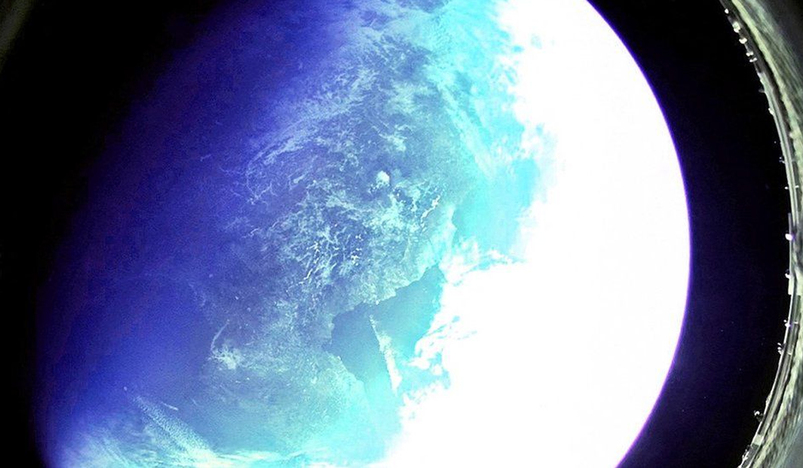
Japan and South Korea say the missile reached a maximum altitude of 2,000km
North Korea has released photographs which it said were taken from its most powerful missile launch in five years.
The unusual pictures taken from space show parts of the Korean peninsula and surrounding areas.
Pyongyang confirmed on Monday it had tested a Hwasong-12 intermediate range ballistic missile (IRBM).
At its full power it can travel thousands of miles, putting areas like US territory Guam within striking distance.
The latest test has raised alarm again among the international community.
Pyongyang has conducted a record number of seven missile launches in the past month alone - an intense flurry of activity that has been strongly condemned by the US, South Korea, Japan, and other nations.
The UN prohibits North Korea from ballistic and nuclear weapons tests, and has imposed strict sanctions. But the East Asian state regularly defies the ban.
US officials on Monday said the recent step up in activity warranted renewed talks with Pyongyang.
What happened at the Hwasong-12 launch?
South Korea and Japan were both the first to report the launch on Sunday after detecting it in their anti-missile systems.
They estimated it had flown a moderate distance for an IRBM, covering a distance of about 800km (497 miles) and reaching an altitude of 2,000km before it landed in waters off Japan. At full power and at a standard trajectory, the missile can travel as far as 4,000km.
North Korea confirmed the missile launch on Monday through its state-run media reports. The country's rogue tests are typically disclosed by state media a day after their occurrence.
State news agency KCNA said the missile test had been launched to "verify its accuracy". It had been deliberately angled to land away "in consideration of the security of the neighbouring countries".
State media also printed unprecedented imagery, some which they said were shots taken by a camera fitted to the missile's warhead.
One of the images shows the moment of launch and another apparently shows the missile in mid-flight, taken from above.
Leader Kim Jong-un was not present to observe Sunday's launch, compared to three weeks ago, when pictures showed his attendance at the launch of a hypersonic glide missile test - a more advanced type of missile technology designed to circumvent missile-detection systems. Those missiles have only been tested by North Korea three times in total.North Korea confirmed the missile launch on Monday through its state-run media reports. The country's rogue tests are typically disclosed by state media a day after their occurrence.
State news agency KCNA said the missile test had been launched to "verify its accuracy". It had been deliberately angled to land away "in consideration of the security of the neighbouring countries".
State media also printed unprecedented imagery, some which they said were shots taken by a camera fitted to the missile's warhead.
One of the images shows the moment of launch and another apparently shows the missile in mid-flight, taken from above.
Leader Kim Jong-un was not present to observe Sunday's launch, compared to three weeks ago, when pictures showed his attendance at the launch of a hypersonic glide missile test - a more advanced type of missile technology designed to circumvent missile-detection systems. Those missiles have only been tested by North Korea three times in total.
Source: BBC
.jpg)
Qatar Secures Place Among the World's Top 10 Wealthiest Nations
.jpg)
Hamad International Airport Witnesses Record Increase in Passenger Traffic

Saudi Arabia: Any visa holder can now perform Umrah

What are Qatar's Labour Laws on Annual Leave?
Leave a comment